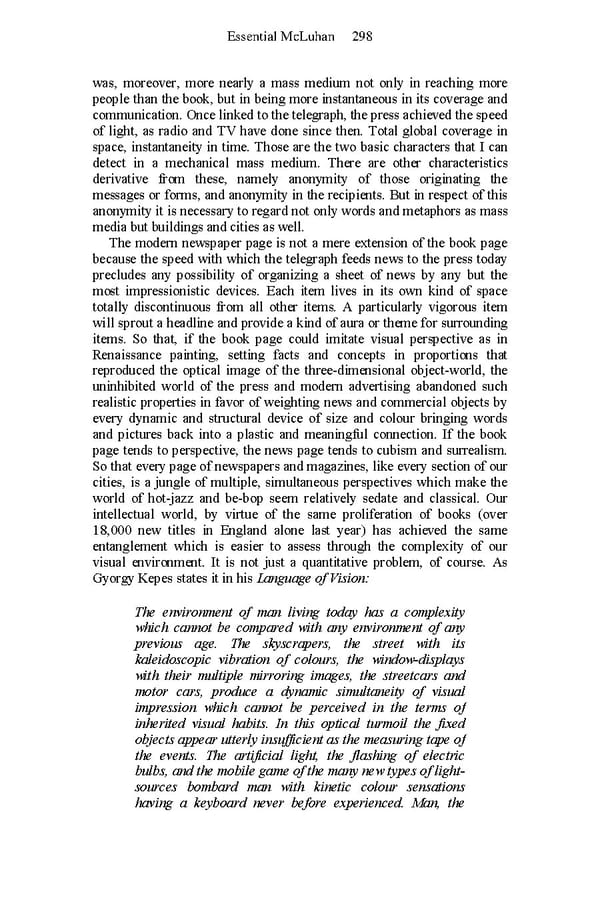Essential McLuhan 298 was, moreover, more nearly a mass medium not only in reaching more people than the book, but in being more instantaneous in its coverage and communication. Once linked to the telegraph, the press achieved the speed of light, as radio and TV have done since then. Total global coverage in space, instantaneity in time. Those are the two basic characters that I can detect in a mechanical mass medium. There are other characteristics derivative from these, namely anonymity of those originating the messages or forms, and anonymity in the recipients. But in respect of this anonymity it is necessary to regard not only words and metaphors as mass media but buildings and cities as well. The modern newspaper page is not a mere extension of the book page because the speed with which the telegraph feeds news to the press today precludes any possibility of organizing a sheet of news by any but the most impressionistic devices. Each item lives in its own kind of space totally discontinuous from all other items. A particularly vigorous item will sprout a headline and provide a kind of aura or theme for surrounding items. So that, if the book page could imitate visual perspective as in Renaissance painting, setting facts and concepts in proportions that reproduced the optical image of the three-dimensional object-world, the uninhibited world of the press and modern advertising abandoned such realistic properties in favor of weighting news and commercial objects by every dynamic and structural device of size and colour bringing words and pictures back into a plastic and meaningful connection. If the book page tends to perspective, the news page tends to cubism and surrealism. So that every page of newspapers and magazines, like every section of our cities, is a jungle of multiple, simultaneous perspectives which make the world of hot-jazz and be-bop seem relatively sedate and classical. Our intellectual world, by virtue of the same proliferation of books (over 18,000 new titles in England alone last year) has achieved the same entanglement which is easier to assess through the complexity of our visual environment. It is not just a quantitative problem, of course. As Gyorgy Kepes states it in his Language of Vision: The environment of man living today has a complexity which cannot be compared with any environment of any previous age. The skyscrapers, the street with its kaleidoscopic vibration of colours, the window-displays with their multiple mirroring images, the streetcars and motor cars, produce a dynamic simultaneity of visual impression which cannot be perceived in the terms of inherited visual habits. In this optical turmoil the fixed objects appear utterly insufficient as the measuring tape of the events. The artificial light, the flashing of electric bulbs, and the mobile game of the many new types of light- sources bombard man with kinetic colour sensations having a keyboard never before experienced. Man, the
 Essential McLuhan Page 304 Page 306
Essential McLuhan Page 304 Page 306